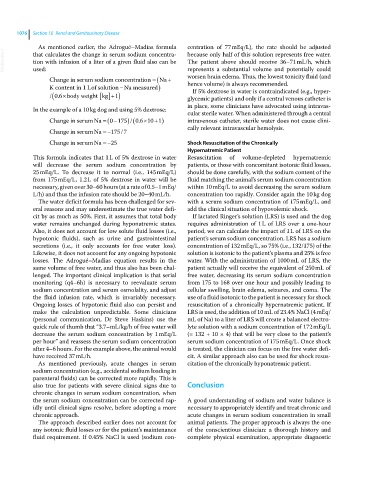Page 1138 - Clinical Small Animal Internal Medicine
P. 1138
1076 Section 10 Renal and Genitourinary Disease
As mentioned earlier, the Adrogué–Madias formula centration of 77 mEq/L), the rate should be adjusted
VetBooks.ir that calculates the change in serum sodium concentra- because only half of this solution represents free water.
The patient above should receive 36–71 mL/h, which
tion with infusion of a liter of a given fluid also can be
represents a substantial volume and potentially could
used:
worsen brain edema. Thus, the lowest tonicity fluid (and
Change in serum sodium concentration Na
K content in Loff solution Na measured hence volume) is always recommended.
1
If 5% dextrose in water is contraindicated (e.g., hyper-
/.06 body weight kg 1 glycemic patients) and only if a central venous catheter is
in place, some clinicians have advocated using intravas-
In the example of a 10 kg dog and using 5% dextrose:
cular sterile water. When administered through a central
Change in serum Na 0 175 / 06 10 1 intravenous catheter, sterile water does not cause clini-
.
cally relevant intravascular hemolysis.
Change in serum Na 175 7
/
Change in serum Na 25 Shock Resuscitation of the Chronically
Hypernatremic Patient
This formula indicates that 1 L of 5% dextrose in water Resuscitation of volume‐depleted hypernatremic
will decrease the serum sodium concentration by patients, or those with concomitant isotonic fluid losses,
25 mEq/L. To decrease it to normal (i.e., 145 mEq/L) should be done carefully, with the sodium content of the
from 175 mEq/L, 1.2 L of 5% dextrose in water will be fluid matching the animal’s serum sodium concentration
necessary, given over 30–60 hours (at a rate of 0.5–1 mEq/ within 10 mEq/L to avoid decreasing the serum sodium
L/h) and thus the infusion rate should be 20–40 mL/h. concentration too rapidly. Consider again the 10 kg dog
The water deficit formula has been challenged for sev- with a serum sodium concentration of 175 mEq/L, and
eral reasons and may underestimate the true water defi- add the clinical situation of hypovolemic shock.
cit by as much as 50%. First, it assumes that total body If lactated Ringer’s solution (LRS) is used and the dog
water remains unchanged during hyponatremic states. requires administration of 1 L of LRS over a one‐hour
Also, it does not account for low solute fluid losses (i.e., period, we can calculate the impact of 1 L of LRS on the
hypotonic fluids), such as urine and gastrointestinal patient’s serum sodium concentration. LRS has a sodium
secretions (i.e., it only accounts for free water loss). concentration of 132 mEq/L, so 75% (i.e., 132/175) of the
Likewise, it does not account for any ongoing hypotonic solution is isotonic to the patient’s plasma and 25% is free
losses. The Adrogué–Madias equation results in the water. With the administration of 1000 mL of LRS, the
same volume of free water, and thus also has been chal- patient actually will receive the equivalent of 250 mL of
lenged. The important clinical implication is that serial free water, decreasing its serum sodium concentration
monitoring (q4–6h) is necessary to reevaluate serum from 175 to 168 over one hour and possibly leading to
sodium concentration and serum osmolality, and adjust cellular swelling, brain edema, seizures, and coma. The
the fluid infusion rate, which is invariably necessary. use of a fluid isotonic to the patient is necessary for shock
Ongoing losses of hypotonic fluid also can persist and resuscitation of a chronically hypernatremic patient. If
make the calculation unpredictable. Some clinicians LRS is used, the addition of 10 mL of 23.4% NaCl (4 mEq/
(personal communication, Dr Steve Haskins) use the mL of Na) to a liter of LRS will create a balanced electro-
quick rule of thumb that “3.7–mL/kg/h of free water will lyte solution with a sodium concentration of 172 mEq/L
decrease the serum sodium concentration by 1 mEq/L (= 132 + 10 × 4) that will be very close to the patient’s
per hour” and reassess the serum sodium concentration serum sodium concentration of 175 mEq/L. Once shock
after 4–6 hours. For the example above, the animal would is treated, the clinician can focus on the free water defi-
have received 37 mL/h. cit. A similar approach also can be used for shock resus-
As mentioned previously, acute changes in serum citation of the chronically hyponatremic patient.
sodium concentration (e.g., accidental sodium loading in
parenteral fluids) can be corrected more rapidly. This is
also true for patients with severe clinical signs due to Conclusion
chronic changes in serum sodium concentration, when
the serum sodium concentration can be corrected rap- A good understanding of sodium and water balance is
idly until clinical signs resolve, before adopting a more necessary to appropriately identify and treat chronic and
chronic approach. acute changes in serum sodium concentration in small
The approach described earlier does not account for animal patients. The proper approach is always the one
any isotonic fluid losses or for the patient’s maintenance of the conscientious clinician: a thorough history and
fluid requirement. If 0.45% NaCl is used (sodium con- complete physical examination, appropriate diagnostic

